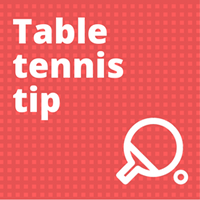When you go to a practice session, you probably have a number of things you want to work on. It could be service, receive, 3rd ball attack, 5th ball attack, topspins, flicks, smashes, stroke combinations, match-play or something else entirely. Some of these things you’ll already be pretty good at, other things not quite so good. So you have an important decision to make, do you prioritise working on your strengths or your weaknesses?
Players often fall into one of two categories:
The weakness avoider
This is a player who consciously or subconsciously avoids practicing a weakness in their game. It could be a lack of self-belief “I’m just not very good at this”, under-developed technique “I don’t know how to do this” or reluctance to change “my game is fine as it is”. Whatever the reason, the outcome is always the same – the weakness never improves.
I’ve definitely spent a lot of time in this category in the past. My major weakness? My backhand. When I was learning to play my backhand was by far my weaker side. I could do a backhand push ok, but a backhand drive, topspin or flick? Forget it. So when it came to practice, I would much prefer to work on my forehand. It was my stronger side and I could hold my own in forehand rallies with much stronger players. And quite frankly, it’s more enjoyable to practice something you’re good at.
Practising backhand strokes just wasn’t much fun. But, of course, this meant my backhand never improved. I would try and hide my weakness by playing a predominantly forehand oriented game. Against weaker opponents, I could get away with it, but stronger opponents could easily spot my weakness and exploit it. Not working on a glaring weakness was preventing me from playing at a higher level.
The weakness addict
The other extreme is the player who gets fixated on their weaknesses. They will often focus on what didn’t go well in matches and use subsequent practice sessions to work on any perceived weaknesses. This approach doesn’t always allow much time for a player to work on their strengths. Through lack of practice, their supposedly stronger shots stagnate and can even deteriorate, leaving the player somewhat frustrated.
Again I have spent time in this category. To improve my backhand, I decided I needed to focus all my practice on backhand drives, topspins and flicks. And my backhand did improve, albeit not as quickly as I would have liked (and it’s still a work in progress!). But all of this focus on my backhand meant I wasn’t spending much time on my forehand and I was beginning to make more forehand errors than usual.
Quite simply, my forehand had lost its sharpness. This left me very frustrated. My backhand had improved, but not as much as I needed it to, but forehand had got a bit worse. It felt like my game was in limbo. I needed to make a change.
The middle ground
As with so much in life, there is a middle ground, which is often the best option. As a player and coach, I strongly advocate spending sufficient time working on both your strengths and your weaknesses.
There’s no golden rule on how much time, e.g. 50% on weaknesses, 50% on strengths. The time spent on each will vary from player to player. If a weaknesses is causing you to lose too many points, you may need to spend more time working on the weakness. But you should still allow time to work on your strengths too. Whereas if you have no major weakness, you may spend more time on your strengths, but still allow time for areas of your game which aren’t quite so strong.
For me, I managed to find that balance. I still spend plenty of time working on my backhand topspins and flicks, but I don’t neglect my trusty forehand anymore. To have any chance to compete with stronger opponent’s I need both backhand and forehand to be working well. And the only way this will happen is if I practice both.

